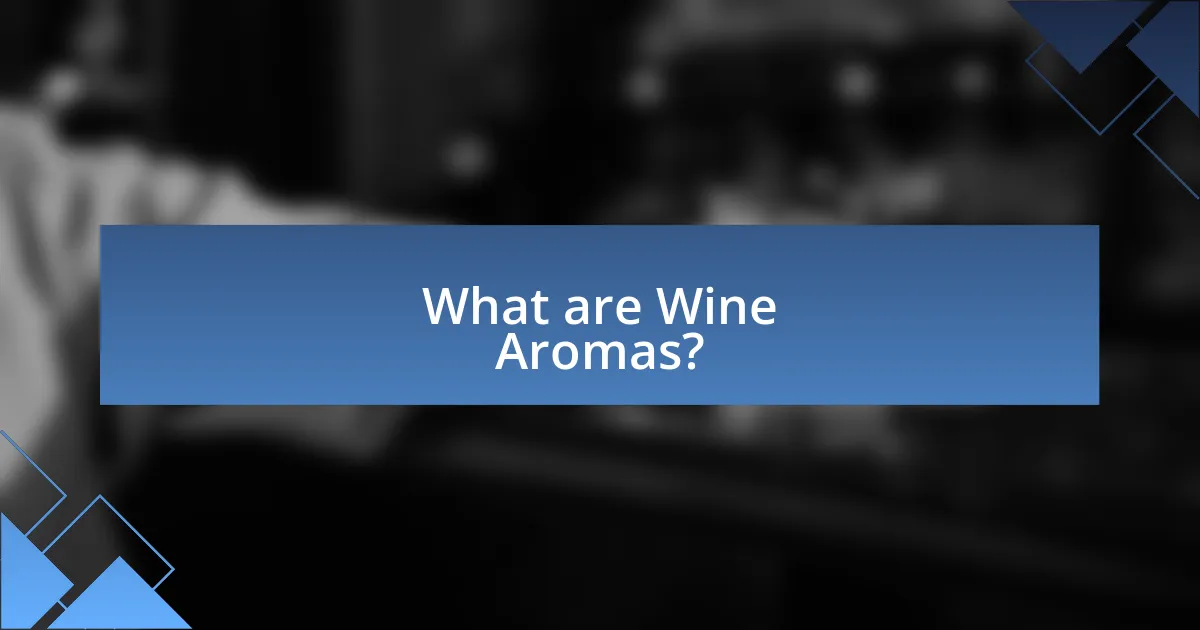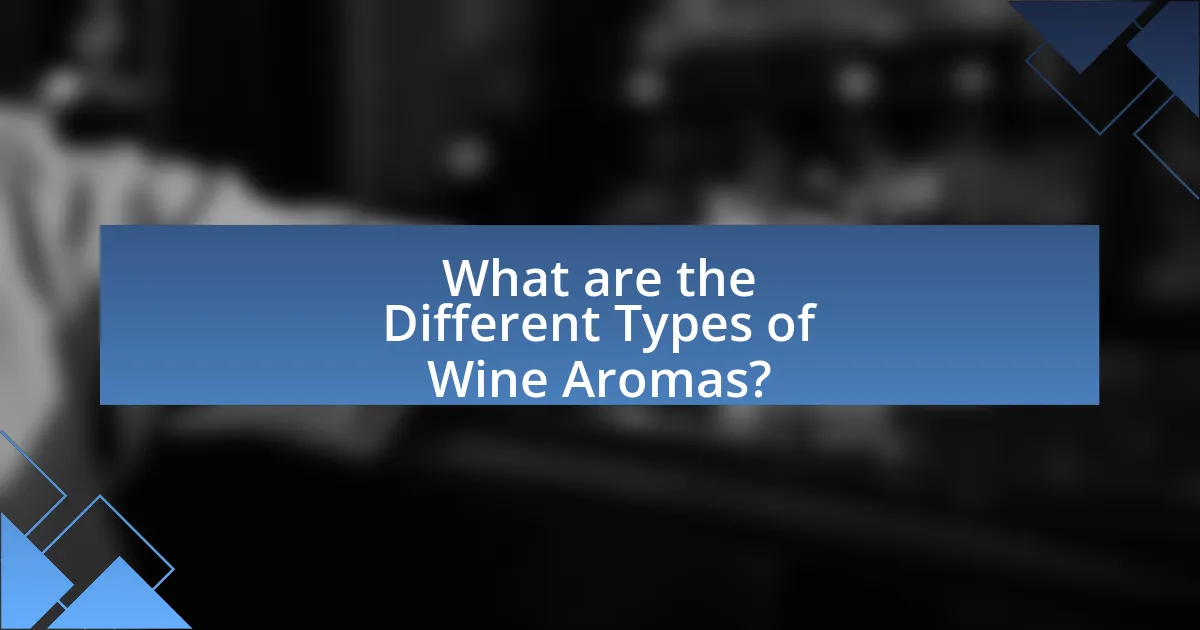The article focuses on understanding wine aromas, which are essential scents that contribute to a wine’s flavor profile. It explores how these aromas develop through grape variety, fermentation processes, and aging, highlighting the significance of environmental factors such as terroir. The article categorizes wine aromas into primary, secondary, and tertiary types, detailing how each type influences the tasting experience. Additionally, it provides techniques for identifying wine aromas, common mistakes to avoid, and practical tips for enhancing aroma recognition skills, emphasizing the critical role of olfactory perception in wine appreciation.

What are Wine Aromas?
Wine aromas are the scents that emanate from wine, which contribute significantly to its overall flavor profile. These aromas arise from various compounds produced during the fermentation process, as well as from the grapes themselves, and can include fruity, floral, herbal, and earthy notes. Research indicates that the perception of these aromas is crucial for wine tasting, as it enhances the sensory experience and influences the overall enjoyment of the wine. For example, studies have shown that specific grape varieties are associated with distinct aromatic profiles, such as Cabernet Sauvignon exhibiting blackcurrant and green bell pepper notes, while Chardonnay may present aromas of apple and butter.
How do Wine Aromas develop?
Wine aromas develop through a combination of grape variety, fermentation processes, aging, and environmental factors. The specific compounds responsible for these aromas are formed during the ripening of grapes, where sugars and acids interact, leading to the production of volatile aroma compounds. During fermentation, yeast converts sugars into alcohol and carbon dioxide, simultaneously producing esters and phenols that contribute to the wine’s bouquet. Additionally, aging in barrels or bottles allows for further chemical reactions, enhancing complexity and depth of aromas. Research indicates that factors such as terroir, which includes soil composition and climate, also significantly influence the aromatic profile of the wine.
What role do grapes play in creating Wine Aromas?
Grapes are fundamental in creating wine aromas due to their inherent chemical compounds, which contribute to the wine’s bouquet. The variety of grape influences the specific aromas produced; for example, Cabernet Sauvignon is known for its dark fruit notes, while Chardonnay can exhibit citrus and floral characteristics. These aromas arise from volatile compounds such as esters, terpenes, and phenols present in the grape skins, pulp, and seeds. Research indicates that the terroir, or environmental factors, also affects these compounds, further shaping the aromatic profile of the wine. Thus, the grape variety and its growing conditions are crucial in determining the aromatic complexity of the resulting wine.
How does the fermentation process influence Wine Aromas?
The fermentation process significantly influences wine aromas by converting sugars into alcohol and producing various volatile compounds. During fermentation, yeast metabolizes sugars, resulting in the formation of esters, phenols, and higher alcohols, which contribute to the complexity of aromas. For example, esters are responsible for fruity notes, while phenolic compounds can impart floral or spicy characteristics. Research indicates that specific yeast strains can enhance particular aroma profiles, demonstrating the importance of yeast selection in winemaking. Additionally, fermentation temperature affects the production of these aromatic compounds; higher temperatures often lead to increased ester formation, enhancing the wine’s aromatic intensity.
Why are Wine Aromas important for tasting?
Wine aromas are crucial for tasting because they significantly influence the overall sensory experience and perception of flavor. The olfactory system plays a vital role in taste, as approximately 80% of what we perceive as flavor comes from our sense of smell. Aromas contribute to the identification of specific varietals, regions, and aging processes, allowing tasters to discern complex notes such as fruit, floral, and earthy characteristics. Research indicates that trained wine tasters can identify over 1,000 different aromas, underscoring the importance of olfactory cues in wine evaluation. Thus, understanding wine aromas enhances appreciation and enjoyment of the beverage.
How do Wine Aromas enhance the overall tasting experience?
Wine aromas significantly enhance the overall tasting experience by engaging the olfactory senses, which are crucial for flavor perception. The human sense of smell contributes approximately 80% of what we perceive as taste, making aromas essential for a complete tasting experience. Specific compounds in wine, such as esters and terpenes, create distinct aromas that can evoke memories and emotions, further enriching the tasting process. For example, a wine with fruity notes may remind a taster of fresh berries, enhancing enjoyment and connection to the wine. Studies have shown that the complexity of aromas can influence a taster’s perception of quality and preference, indicating that a wine’s aromatic profile plays a vital role in its overall appreciation.
What is the relationship between Wine Aromas and flavor perception?
Wine aromas significantly influence flavor perception, as they contribute to the overall tasting experience. The human sense of taste is closely linked to the sense of smell; approximately 80% of what we perceive as flavor comes from aromas detected through the olfactory system. Research indicates that specific volatile compounds in wine, such as esters and terpenes, create distinct aromas that enhance the complexity and richness of flavors experienced when tasting wine. For example, a wine with fruity aromas may evoke flavors of apple or peach, while earthy aromas can suggest flavors of mushroom or soil. This interplay between aroma and flavor perception is essential for wine appreciation and is supported by studies in sensory science that demonstrate how olfactory cues can alter taste perception.

What are the Different Types of Wine Aromas?
The different types of wine aromas can be categorized into three main groups: primary, secondary, and tertiary aromas. Primary aromas originate from the grape variety and include fruity, floral, and herbal notes. Secondary aromas develop during fermentation and can include yeasty or buttery characteristics. Tertiary aromas arise from aging and may present earthy, nutty, or spicy scents. These classifications help in identifying and appreciating the complexity of wine.
What are primary, secondary, and tertiary aromas?
Primary aromas are the initial scents derived directly from the grape variety used in winemaking, such as fruity or floral notes. Secondary aromas develop during fermentation and are influenced by the winemaking process, often including yeasty or buttery characteristics. Tertiary aromas emerge with aging, resulting from chemical changes in the wine, and can include complex notes like nutty, earthy, or spicy elements. These classifications help in identifying and understanding the overall profile of a wine, enhancing the tasting experience.
How can one identify primary aromas in wine?
To identify primary aromas in wine, one should engage in a systematic approach that includes visual inspection, swirling the glass, and inhaling deeply. Primary aromas, which originate from the grape variety, can be detected through these methods as they are often fruity, floral, or herbal in nature. For instance, a Sauvignon Blanc may exhibit citrus or green bell pepper notes, while a Chardonnay might present apple or pear characteristics. Research indicates that the olfactory system can distinguish thousands of different scents, allowing trained tasters to recognize specific primary aromas effectively.
What are examples of secondary aromas and how do they form?
Secondary aromas in wine include notes such as butter, cream, and toast, which typically arise from the process of malolactic fermentation and the aging of wine in oak barrels. Malolactic fermentation converts sharp malic acid into softer lactic acid, producing buttery aromas, while the interaction with oak can impart toasty, vanilla, and spice notes due to the breakdown of lignin and cellulose in the wood during aging. These processes are essential in developing the complexity and depth of a wine’s aromatic profile.
How do environmental factors affect Wine Aromas?
Environmental factors significantly influence wine aromas by affecting grape development and the chemical compounds produced during fermentation. Factors such as climate, soil composition, and vineyard management practices determine the concentration of volatile compounds, which are crucial for aroma. For instance, warmer temperatures can enhance the production of fruity esters, while cooler climates may lead to more floral and herbal notes. Additionally, soil types contribute minerals that can alter the flavor profile, as seen in regions like Burgundy, where limestone-rich soils impart distinct mineral characteristics to the wine. Studies have shown that these environmental conditions directly correlate with the aromatic complexity and overall quality of the wine, underscoring the importance of terroir in winemaking.
What impact does terroir have on Wine Aromas?
Terroir significantly influences wine aromas by encompassing the unique combination of soil, climate, and topography in a specific vineyard location. This combination affects the grapevine’s growth and the chemical composition of the grapes, which in turn shapes the aromatic profile of the wine produced. For instance, studies have shown that different soil types can impart distinct mineral notes, while climate variations can enhance or diminish fruity, floral, or herbal aromas. Research published in the Journal of Agricultural and Food Chemistry indicates that specific compounds responsible for aromas, such as terpenes and esters, are affected by the terroir, leading to diverse aromatic expressions in wines from different regions.
How do aging conditions influence Wine Aromas?
Aging conditions significantly influence wine aromas by altering the chemical composition of the wine through processes such as oxidation, evaporation, and interaction with the storage environment. For instance, wines aged in oak barrels develop complex aromas due to the extraction of compounds like vanillin and tannins from the wood, which contribute notes of vanilla, spice, and toast. Additionally, temperature and humidity levels during aging can affect the rate of these chemical reactions; optimal conditions enhance desirable aromatic compounds while preventing spoilage. Research indicates that wines aged in cooler, stable environments tend to retain more fruit-forward aromas, while those exposed to higher temperatures may develop more oxidative notes, such as nutty or sherry-like characteristics.

How Can You Identify Wine Aromas?
To identify wine aromas, one should engage in a systematic approach that includes swirling the wine in the glass, inhaling deeply, and recognizing distinct scents. This method allows the individual to release volatile compounds, enhancing the olfactory experience. Research indicates that trained tasters can identify over 200 different aromas in wine, including fruity, floral, and earthy notes, which are categorized based on the grape variety and winemaking process. For instance, a Cabernet Sauvignon may exhibit aromas of blackcurrant and cedar, while a Chardonnay might present notes of apple and butter.
What techniques can help in identifying Wine Aromas?
Techniques that can help in identifying wine aromas include systematic sniffing, using aroma kits, and practicing with food pairings. Systematic sniffing involves taking short, deliberate inhalations to isolate specific scents, enhancing the ability to recognize various aromas. Aroma kits, which contain vials of different scents commonly found in wines, provide a reference point for comparison and training the nose. Additionally, practicing with food pairings allows individuals to connect aromas with flavors, reinforcing memory and recognition of specific wine characteristics. These methods are supported by sensory analysis research, which emphasizes the importance of training and experience in developing olfactory skills.
How does the process of swirling and sniffing work?
The process of swirling and sniffing involves aerating the wine to release its aromatic compounds, enhancing the olfactory experience. Swirling the wine in the glass increases its surface area, allowing volatile aroma compounds to evaporate more readily. When a person sniffs the wine afterward, they inhale these compounds, which stimulate the olfactory receptors in the nose, enabling the identification of various aromas. Research indicates that the human nose can detect thousands of different scents, and the swirling action significantly amplifies this sensory perception by promoting the release of esters, terpenes, and other aromatic molecules present in the wine.
What role does a wine aroma wheel play in identification?
A wine aroma wheel serves as a visual tool that aids in the identification of various aromas present in wine. This wheel categorizes and organizes different scent descriptors, allowing wine tasters to systematically recognize and articulate the complex aromas they encounter. By providing a structured framework, the aroma wheel enhances sensory analysis and improves communication about wine characteristics among enthusiasts and professionals alike. Studies have shown that using such tools can significantly increase the accuracy of aroma identification, thereby enriching the overall tasting experience.
What common mistakes should be avoided when identifying Wine Aromas?
Common mistakes to avoid when identifying wine aromas include relying solely on preconceived notions, neglecting to use all senses, and failing to take notes. Relying on preconceived notions can lead to confirmation bias, where individuals only recognize aromas they expect to find, thus missing out on the full spectrum of scents present. Neglecting to engage all senses, such as sight and taste, can limit the overall experience and understanding of the wine’s profile. Additionally, failing to take notes can hinder the ability to remember and compare aromas across different wines, which is essential for developing a refined palate. These mistakes can significantly impact the accuracy of aroma identification and overall wine appreciation.
How can bias affect aroma identification?
Bias can significantly affect aroma identification by influencing an individual’s perception and interpretation of scents. Research indicates that prior experiences, cultural background, and personal preferences can shape how aromas are recognized and categorized. For instance, a study published in the journal “Chemical Senses” by A. J. de Araujo et al. found that individuals with different cultural backgrounds may identify the same aroma differently based on their exposure to certain scents in their environment. This suggests that bias can lead to inconsistent aroma identification, as individuals may favor familiar scents over unfamiliar ones, impacting their overall assessment of aromas in wine.
What are some tips for improving aroma recognition skills?
To improve aroma recognition skills, practice regularly by smelling a variety of substances, such as fruits, spices, and herbs. Engaging in systematic smelling exercises helps train the olfactory system to identify and differentiate aromas. Research indicates that repeated exposure to specific scents enhances the brain’s ability to recognize and recall those aromas, as demonstrated in studies on olfactory memory. Additionally, keeping a scent journal to document experiences and associations with different aromas can further solidify recognition skills.
What are practical tips for enhancing your wine aroma experience?
To enhance your wine aroma experience, focus on proper glassware, swirling, and mindful breathing. Using a tulip-shaped glass allows for better concentration of aromas, as it narrows at the top, trapping scents. Swirling the wine aerates it, releasing volatile compounds that contribute to the aroma profile. Additionally, taking slow, deliberate breaths while inhaling the wine’s aroma helps to identify specific notes, as studies show that the olfactory system is sensitive to subtle differences in scent. Engaging in these practices can significantly improve the overall sensory experience of wine tasting.


